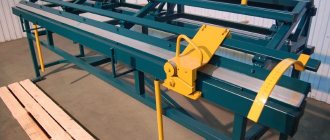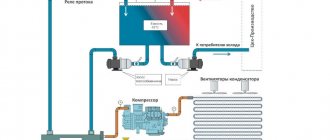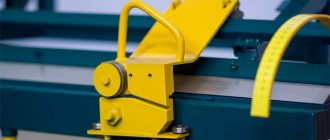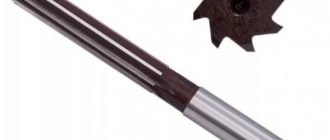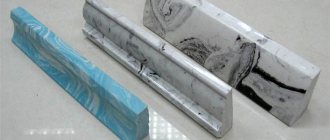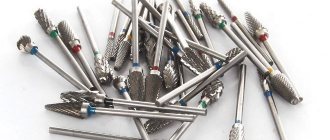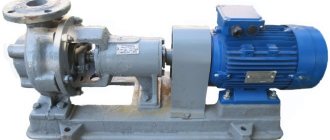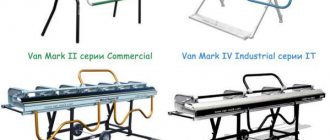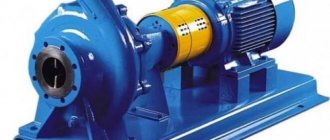A segment bending machine allows you to produce products of various configurations from sheet metal. The versatility of such equipment makes it possible to successfully use it not only in various industries, but also in the construction sector.
A manual segmented sheet bender is much superior in capabilities to its counterpart with a non-separable working surface
Types of sheet metal bending equipment
A sheet bender, which you can make yourself, is a device that allows you to perform not only bending, but also cutting of metal sheets. Such equipment can be found today in almost any manufacturing enterprise. It was first used back in the 19th century, when there was a sharp leap in the development of industrial technologies.
Using segment bending machines you can make trays, casings, air ducts, profiles, clamps and much more.
The first devices for this purpose were manual; much later, hydraulic and electromechanical sheet benders began to appear. Today, when modern technologies have made great strides, manufacturers offer metal processing specialists sheet bending machines that operate in a fully automated mode, equipment with electromagnetic clamps and other types of bending devices.
If initially machines for bending sheet metal were used only to equip large manufacturing enterprises, today even for domestic purposes or the needs of a small workshop you can purchase a compact electromechanical or manual machine that allows you to perform a large range of bending operations.
Most segment benders are equipped with a circular knife for cutting workpieces
Plate benders differ not only in the type of drive installed on them, but also in the type of working parts. Thus, there are roller and roller benders, as well as devices with a rotating beam.
Completely unique in their design are segmental sheet bending machines, which began to be actively used relatively recently. In fact, such a machine is a sheet bending machine with a rotating beam. Its peculiarity lies in the fact that its working body, which affects the metal sheet, deforming it, is composed of separate segments. Segmental (segmental, segmental) sheet bending, due to the features of its design, allows, using one piece of equipment, to bend products of various sizes and configurations. Thus, segment benders are more versatile devices than a standard bender with a rotary beam.
The beams of a segment bending machine consist of sections that can be moved and changed, selecting almost any required working size
The modern market offers a variety of sheet metal bending equipment, differing both in its functionality and in its main technical characteristics - power, productivity, level of automation, etc. Thanks to this variety, choosing a segment sheet bending machine is not difficult for manufacturers and home craftsmen.
Segment benders
Bending is a non-energy-intensive operation of plastic deformation of metals, and therefore does not require the application of great forces to the bent workpiece. Therefore, hand-operated sheet benders are often used to change the axis of relatively thin (up to 2 - 2.5 mm) steel products. Having the appropriate technical training and equipment, you can even make such a sheet bending machine yourself.
In a single production, the proportion of parts with different configurations is quite large. A traditional press brake with a rigidly fixed shape of the bending die is not justified in such cases. Therefore, more and more often in everyday life, for various construction works, in car repair shops, etc. you can find a manual sheet bender with a segmented working tool.
Manual segment bending machine
Device and principle of operation
A manual segment sheet bender is equipment for bending along the contour of sheet piece products, the equipment of which is represented by a set of standard elements - segments. This sheet bending machine consists of the following units:
- A clamping mechanism on which a set of segments is installed.
- A rotating mechanism that ensures direct bending of the part.
- A manual lever drive for rotating the beam to the required angle (for more powerful units the drive can be foot driven).
- A steel support frame made of rolled profiles on which all components of the unit are mounted.
- Guide devices that ensure the straightness of movement of elements.
- Clamps for installing the original workpiece (magnetic and mechanical are often used).
- Spring compensators (optional), which are designed for more uniform movement of moving parts of equipment.
Segmental working tools (bending dies) are usually made of alloy tool steel grades 9ХС or ХВГ. The set of segments has a working and a landing part. The landing part of each matrix corresponds to the place of its attachment, and the working part is designed for the most common options for bending parts.
Tool production is the best option for ordering tools, since the dies must have a low roughness of Ra 1.6 - 2.5 with a hardness in the range of 52 - 57 HRC.
Since a manual sheet bender most often does not have a device for adjusting the stroke of the movable beam, the height that the segment tool has is the same for all dies.
Plate bending segmentsProducts of a segment bending machine - box-shaped part
A segmental manual sheet bender works like this. Before bending begins, the operator selects the required set of dies and installs the segment tool into the seat. The workpiece prepared for bending is installed in the gap between the clamping and working beams, fixed to pre-set stops, and securely clamped.
Using a handle, the rotating mechanism moves to the required angle, and, in the process of pressing the workpiece to the desired matrix, compresses the product along its working part.
The return of this unit can be done either by turning the handle back, or by the action of a special spring (some industrial sheet bending machines have this capability).
Technical capabilities of manual segment benders
The models offered on the market provide:
- bending of steel thin-sheet products up to 1.5 m long;
- bending of products made of non-ferrous metals and alloys (mainly aluminum and copper with a thickness of up to 2.5 - 3 mm) up to 4 m long;
- bend angle 135 - 180°;
- possibility of installing pre-curved edges of semi-finished products in the machine.
Bending accuracy is ensured by preliminary adjustment of the gaps in the turning mechanism. To increase functionality, some models of such units are equipped with a roller-type cutting knife, with which you can perform a number of separation operations (for example, cutting).
A do-it-yourself segment sheet bender usually does not have the full range of the functions described above. Usually it is made to meet specific production needs.
In particular, to reduce overall production costs, it is advisable to make a segmented tool from ordinary tool steel grades U10 or U12. The range of segments is also more limited.
For non-magnetic materials, the workpiece is clamped during the bending process by a screw mechanism; for processing steel workpieces, it is more practical to use a magnetic clamp.
The designs of this type of equipment also differ in the location of the segments: in most models vertical placement is accepted, but inclined placement is also found. The choice is determined by the convenience of the work: in particular, with small-height matrices, sets of bending segments can be placed vertically, and with significant bending strokes, an inclined arrangement is more convenient.
Most often, manual segment bending is used for the production of products such as boxes and lids: pallets, enclosing casings, baking sheets, housings for ventilation devices, etc.
One of the segmental sheet bending schemes
Work on obtaining this equipment with your own hands begins with the production of drawings. The design of the unit must be designed for the specific needs of production and for a given production program in order to avoid unnecessary financial costs.
There are recommendations that such a sheet bending machine can even be made from wood, but the functionality of the equipment will be very limited, and the labor intensity of processing durable wood (hornbeam, beech, pear) is quite comparable to the cost of metal processing.
Electrically driven machines
Manual segment bending machine is highly efficient and simple in design, but it also has a number of disadvantages, the most significant of which are low power and low productivity. To significantly improve the technical characteristics of such equipment, an electromechanical drive is installed on a segment or any other sheet bending machine.
Electromechanical sheet bender LGM-6 is designed for cold bending of metal up to 6 mm thick
The main elements of a segment bending machine equipped with an electromechanical drive are:
- the bed on which all other components of the machine are mounted;
- pressing and bending mechanisms, which are driven by electric motors;
- the electromechanical drive itself;
- guides and locking elements that ensure correct positioning and movement of the metal sheet during processing;
- workpiece fixation mechanisms, which can be either mechanical or electromagnetic;
- cabinet for electrical equipment and machine controls.
In order to increase the power of an electromechanical sheet bending machine, it is additionally equipped with gearboxes, which leads to a significant increase in its size and weight.
What is a segment bending machine and which one to choose?
Choosing a segmental sheet bender
The need for working with sheet metal is significant, and there is a large list of products that have a wide range of applications. One of the main operations that are carried out with a metal sheet is bending. With its help, you can obtain products from extremely simple to very complex configurations.
For bending sheet metal, special sheet bending machines are used, which are also called sheet benders. By and large, a sheet bending machine is a press designed to give a steel sheet one shape or another. There are many types of classification of this type of equipment. According to the motive force used, they can be divided into:
- manual;
- hydraulic;
- electromechanical.
If we take into account the bending option, the sheet bender can be:
- press;
- rotational;
- rotary.
With the help of sheet bending machines, various products are produced, including roofing components, windows, ventilation shafts, metal siding, frames, doors, drawers and other similar products.
Manual segment bending machine is the most commonly used machine for working with sheet metal in small workshops.
Features of segment bending machines
If you look at the photo and compare a manual segment bending machine with a conventional one, you can immediately notice the design feature of the first one. Its clamping beam (and often bending beam) is not solid, but stacked. It is the presence of typesetting elements that makes it possible to produce products of almost any configuration, with bends in different directions and not necessarily at right angles.
Before starting work, the segment bending machine must be configured accordingly. Setting up consists of arranging removable elements in such a way that when bending a metal sheet, a product of the required shape is obtained.
Even a simple manual segment bending machine, but equipped with angle gauges, sheet feed depth limiters and other devices, allows you to carry out work at a high level of quality, with great accuracy. Typically, such machines are equipped with roller knives for cutting metal and other tools that allow a wide range of operations to be performed with metal sheets.
Manual segment sheet bending machines are produced by both well-known manufacturers of metalworking equipment and little-known companies. In addition, you can make such a machine yourself, which is important for small businesses, or for those who intend to use a sheet bending machine for personal needs.
Plate bending machine pbb 2a 1270
Manual segment bending machine pbb 2a 1270 is produced by one of the Chinese companies. In many cases, this fact means a good price/quality ratio, as well as good equipment. The machine can be effectively used both for personal needs and for the production of sheet metal products in small batches.
The segment bending machine pbb 2a 1270 is designed for producing products of complex shapes. Its main technical characteristics:
- the presence of segment knives, which make it possible to produce products of complex shapes;
- maximum width of processed metal sheet – 1270 mm;
- maximum sheet thickness – 2 mm;
- width of type-setting segments – from 25 to 1270 mm;
- height of typesetting segments – 30 mm;
- Both the pressing beam and the bending beam consist of removable segments;
- drive type - manual; an air spring is used to uniform the force and reduce the load on the worker.
Decker su 1250 machine
The segment bender decker su 1250, German in origin, is a machine that includes three beams of stacked segments, a roller blade, a protractor, a device for limiting the bending angle, and two support tables.
This segmental sheet bending machine is equipped with specially shaped stacking elements that allow you to produce products with bends at any angle. This means that the range of products produced on the machine can be as wide as possible.
Hydraulic equipment
To further increase the power of sheet-bending equipment, a hydraulic drive is installed on it, which is responsible for the operation of the two main mechanisms of such equipment - clamping and bending. A hydraulic drive is rarely installed on devices with a segmented working body. Most often, they are equipped with a standard sheet bending machine with a rotating beam or roller-type machines. This is explained by the fact that it is simply impractical to use an overly powerful and oversized hydraulic drive for a segmental sheet bending machine, which processes small workpieces.
Hydraulic segment machines will allow you to bend wide-format sheets of considerable thickness
Manual devices
On the modern market you can also purchase a segmental manual sheet bender. Moreover, if you wish, you can make such a sheet bending machine yourself. It is manual sheet bending devices that home craftsmen most often install in their garage or workshop in order to perform simple technological operations with their help.
The main disadvantages of manual devices, as mentioned above, are their low productivity and low power. For this reason, such machines can only be used for cutting and bending metal sheets of very small thickness. In addition, controlling such sheet bending machines, which primarily use a lever mechanism as a drive, requires considerable physical effort, which should also be attributed to the disadvantages of this equipment.
Manual sheet benders can be equipped with special segments for the production of complex elements
Meanwhile, independent production of manual sheet benders allows you to save significant financial resources that would have to be spent on serial models.
Pneumatic equipment
A pneumatic segmental machine for bending sheet metal, like a sheet bender with a rotary beam, equipped with a pneumatic drive, is the least widespread on the modern market. This is explained by the fact that the drive of such machines, which is based on pneumatic cylinders, is unable to provide power sufficient to bend long and thick metal sheets. That is why such a device, which has the largest dimensions among machines of this type, is used only for processing products made of thin sheet steel or small shaped parts.
Pneumatic press brakes process workpieces in dies that can be changed, thereby expanding the capabilities of the equipment
How to choose a segmental sheet bending machine? The difference between two segmental and 3 segmental sheet bending machines
Home / Articles
Metal Master segmental bending machines are designed for bending products with non-parallel bends. MTB3S is a universal sheet bending machine for bending complex spatial / box-shaped products.
MTB2S is a specialized sheet bending machine for the production of pallet-type parts.
MTB 3S
Box brake / Listogib for the production of “boxes”.
All three beams are equipped with segment knives.
The geometry of the working tool allows the production of products with side wall dimensions of up to 100 mm. up and 110 mm. down from the bending plane. In the diagram: Green space is the maximum size of the product, the so-called “clearance” is clearly visible in the photo.
Marked in yellow are three beams with segmental knives.
MTB 3S sheet bender recommended
As the main sheet metal bender for production:
- box products
- housings of payment terminals, safes, etc.
- facade cassettes with hidden fastening
MTB 2S
Pan brake / Pallet sheet bender
Only two beams are equipped with segment knives
The geometry of the working tool allows the production of products with side wall dimensions of only up to 25 mm. and only in one direction In the diagram: Green space is the maximum size of the product, the so-called “clearance” is clearly visible in the photo.
Marked in yellow are two beams with segmental knives.
Electromagnetic type machines
The segmented electromagnetic machine is a relatively new piece of equipment on the modern market, gaining increasing popularity among metalworking specialists. It is not mechanical or hydraulic mechanisms that are responsible for reliable and accurate fixation of the metal sheet on such a sheet bending machine, but powerful electromagnets. This innovative solution, which makes it possible to abandon the massive pressure beam in the design of the sheet bending machine, has made it possible not only to significantly reduce its dimensions and weight, but also to increase the accuracy of the processing performed.
Electromagnetic sheet bending machine STALEX EB 1250×1.6 with the ability to bend up to 135°
The use of a powerful electromagnet, with the help of which the workpiece is reliably pressed to the surface of the work table with a force that can reach up to 4.5 t/m2, allows not only bending metal sheets of considerable thickness, but also producing products of even the most complex configuration with high precision .
Segmental electromagnetic sheet benders, as a rule, are universal equipment. The standard set of such machines, in addition to segment-type working bodies, also includes solid narrow and solid standard beams. Due to the versatility of such machines, they can be purchased not only by large, but also by small manufacturing enterprises engaged in the production of metal products in medium and even single batches.
